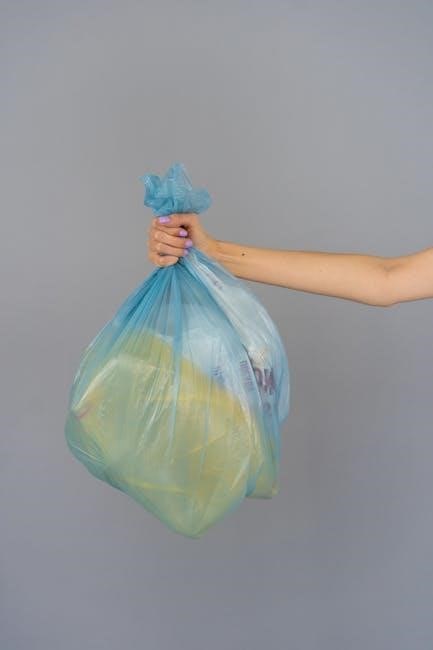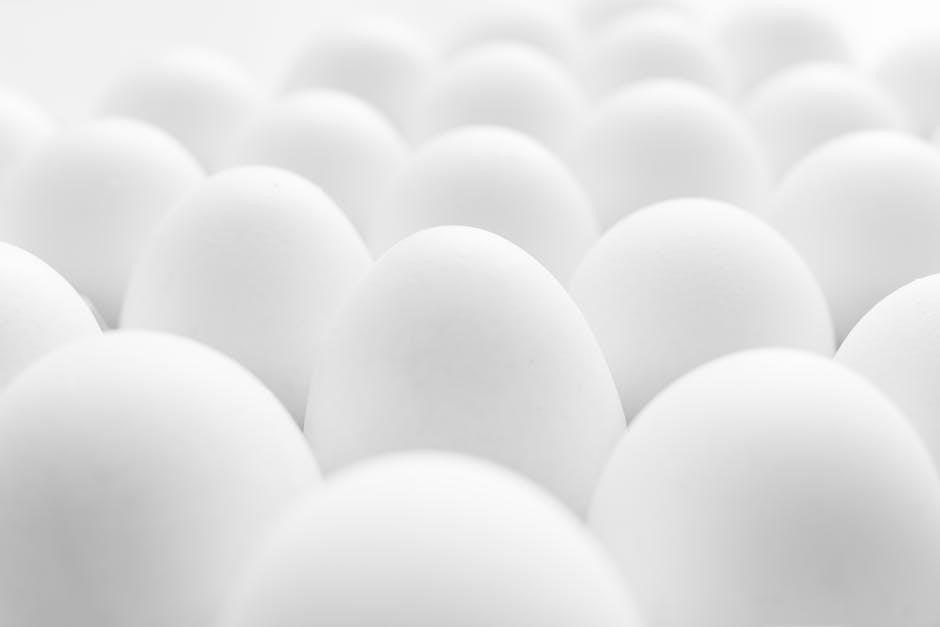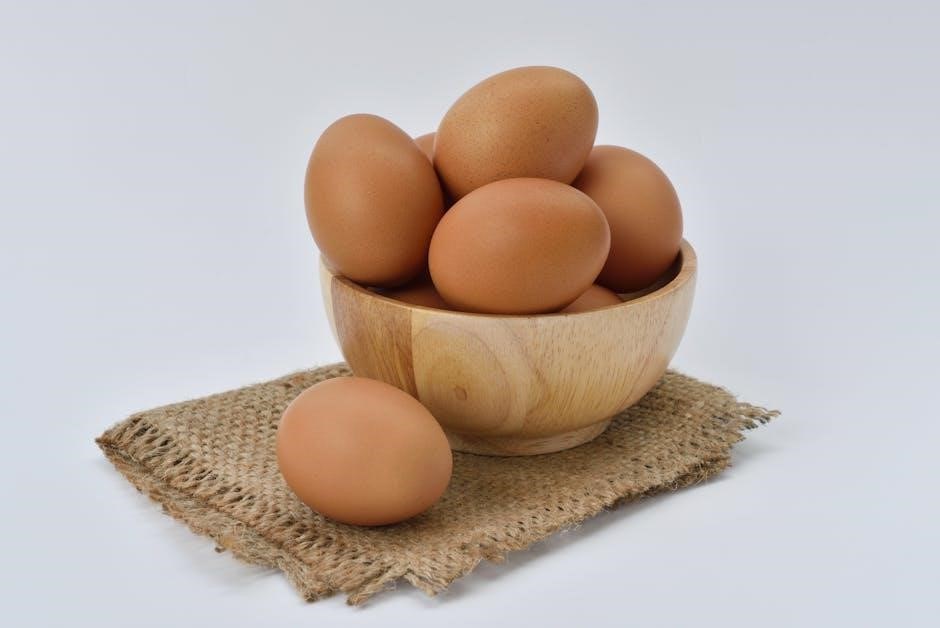The Dirty Dozen and Clean Fifteen are annual lists ranking produce by pesticide residue levels, published by the Environmental Working Group (EWG). These guides help consumers make informed choices, promoting healthier eating habits and reducing pesticide exposure by identifying which fruits and vegetables to buy organic or conventional. The Dirty Dozen highlights produce with the highest pesticide residues, while the Clean Fifteen lists those with the lowest, offering a practical tool for shoppers to prioritize their purchases effectively.
What Are the Dirty Dozen?
The Dirty Dozen is a list of fruits and vegetables with the highest pesticide residues, identified annually by the EWG to guide consumers toward organic options for these items.
2024 Rankings of the Dirty Dozen
The 2024 Dirty Dozen list, published by the EWG, ranks produce with the highest pesticide residues. Strawberries remain at the top for the third consecutive year, followed by spinach, kale, peaches, and pears. Nectarines, apples, and grapes also make the list, highlighting their high pesticide contamination. These rankings emphasize the importance of buying organic for these items to minimize exposure to harmful chemicals. The list is based on extensive testing and analysis of pesticide residues on non-organic produce, providing consumers with clear guidance for healthier choices.
Common Pesticides Found in the Dirty Dozen
Produce on the Dirty Dozen list often contains residues of hazardous pesticides like pyrethroids, organophosphates, and neonicotinoids. These chemicals are linked to potential health risks, including neurological damage and reproductive issues. Strawberries, for instance, frequently test positive for pyrethroids, while spinach and kale may contain organophosphates. The EWG’s analysis reveals that multiple pesticides are often detected on a single sample, raising concerns about cumulative exposure. This underscores the importance of choosing organic options for these items to reduce pesticide intake and protect consumer health effectively.


What Are the Clean Fifteen?
The Clean Fifteen are fruits and vegetables with the lowest pesticide residues, identified annually by the EWG. These items are safer to consume conventionally, reducing exposure to harmful chemicals while maintaining a balanced diet and promoting sustainable eating practices.
2024 Rankings of the Clean Fifteen
In 2024, the Clean Fifteen list, compiled by the EWG, features produce with the lowest pesticide residues. Topping the list are avocados, sweet corn, and pineapple, followed by onions, papaya, and sweet peas (frozen). These items are deemed safer for conventional consumption due to minimal pesticide exposure. The rankings are based on extensive testing of pesticide residues on thousands of fruit and vegetable samples. This guide helps consumers make informed choices, promoting healthier diets while reducing exposure to harmful chemicals. It’s a valuable resource for those aiming to balance affordability and sustainability in their grocery shopping.
- Top Clean Fifteen Items: Avocados, sweet corn, pineapple, onions, papaya, and sweet peas.
- Criteria: Lowest pesticide residue levels detected through rigorous testing.
- Benefit: Safer conventional options for consumers prioritizing health and budget.
Benefits of Choosing Clean Fifteen Produce
Selecting Clean Fifteen produce offers numerous health and practical advantages. These items have the lowest pesticide residues, reducing exposure to harmful chemicals. This makes them safer choices for conventional consumption, especially for budget-conscious shoppers. By prioritizing the Clean Fifteen, consumers can enjoy fresh, nutritious fruits and vegetables while minimizing potential health risks. This list is particularly beneficial for families, helping them make informed, cost-effective decisions without compromising on quality or safety. It’s a simple yet impactful way to promote healthier eating habits and environmental sustainability.
- Lower Pesticide Exposure: Safer for daily consumption.
- Cost-Effective: Conventional options are often more affordable.
- Nutritional Benefits: Encourages higher fruit and vegetable intake.

The Importance of Pesticide Awareness

Understanding pesticide residues is crucial for making informed food choices, reducing health risks, and supporting sustainable farming practices. Awareness empowers consumers to prioritize cleaner options, promoting safer eating habits and environmental responsibility.
How Pesticide Residues Impact Consumer Health
Pesticide residues on produce can pose health risks, particularly for children, pregnant women, and vulnerable populations. Long-term exposure to these chemicals has been linked to issues like neurological damage, developmental delays, and increased cancer risk. Even at low levels, pesticides can accumulate in the body, potentially harming overall health. Understanding and minimizing exposure through informed food choices is essential for protecting consumer well-being and promoting safer eating habits. The Dirty Dozen and Clean Fifteen lists provide a clear guide to help consumers make healthier decisions.
Why Organic Options Matter for Dirty Dozen Produce
Choosing organic options for Dirty Dozen produce is crucial as these items often have the highest pesticide residues. Organic farming avoids synthetic pesticides, significantly reducing exposure to harmful chemicals. This is especially important for vulnerable groups like children and pregnant women. By opting for organic, consumers can lower their intake of toxic substances linked to health risks. Organic produce also supports sustainable agriculture and promotes safer farming practices. Prioritizing organic for the Dirty Dozen helps protect both personal health and the environment, making it a smarter, healthier choice.

How the Dirty Dozen and Clean Fifteen Lists Are Compiled
The Dirty Dozen and Clean Fifteen lists are compiled annually by the EWG, using data from USDA pesticide residue tests. Produce is ranked based on pesticide levels, detection frequency, and average residue intensity. The rankings help consumers identify which fruits and vegetables are most or least contaminated, guiding smarter shopping decisions to reduce pesticide exposure.
EWG’s Methodology for Ranking Produce
The Environmental Working Group (EWG) compiles the Dirty Dozen and Clean Fifteen lists by analyzing pesticide residue data from the U.S. Department of Agriculture (USDA). The methodology involves testing thousands of fruit and vegetable samples annually. Produce is ranked based on factors like pesticide detection frequency, average residue levels, and the number of pesticides found. The EWG also considers the toxicity of detected pesticides. This comprehensive approach ensures consumers receive clear guidance on which produce items are most or least contaminated, helping them make informed choices to minimize pesticide exposure.
Data Sources and Testing Processes
The EWG relies on pesticide residue data from the U.S. Department of Agriculture (USDA), which tests thousands of fruit and vegetable samples each year; The USDA’s rigorous testing includes analyzing produce for over 200 pesticides. Samples are washed and prepared as consumers would before testing to reflect real-world exposure. The EWG then evaluates this data, focusing on residue levels, detection frequency, and the number of pesticides found on each item. This process ensures the Dirty Dozen and Clean Fifteen lists accurately reflect pesticide contamination levels, helping consumers make informed choices.
Expert Insights on the Dirty Dozen and Clean Fifteen
EWG Senior Toxicologist Alexis Temkin, Ph.D., shares expert insights, emphasizing the importance of reducing pesticide exposure through informed produce choices; Her expertise highlights how the lists empower consumers to make healthier decisions.
Interviews with EWG Senior Toxicologist Alexis Temkin, Ph.D.
Alexis Temkin, Ph.D., a senior toxicologist at EWG, provides valuable insights into the Dirty Dozen and Clean Fifteen lists. She emphasizes the importance of understanding pesticide exposure and its impact on consumer health. Temkin highlights how the lists empower shoppers to make informed decisions, reducing their intake of harmful chemicals. She also shares practical tips for incorporating organic options into diets without breaking the bank. Her expertise offers a deeper understanding of the methodology behind the rankings and the significance of choosing cleaner produce for long-term health benefits.
Key Takeaways from Recent Studies
Recent studies reinforce the importance of the Dirty Dozen and Clean Fifteen lists in minimizing pesticide exposure. Research indicates that consuming produce with higher pesticide residues may pose health risks, particularly for children and pregnant women. These studies highlight the effectiveness of choosing organic options for items on the Dirty Dozen list and conventional produce from the Clean Fifteen. They also emphasize the long-term benefits of reducing pesticide intake, aligning with the EWG’s mission to promote sustainable and healthier eating habits through informed consumer choices.

Practical Tips for Using the Dirty Dozen and Clean Fifteen Lists
Check the Dirty Dozen and Clean Fifteen lists before shopping to make informed choices. Prioritize organic for high-residue items and opt for conventional produce from the Clean Fifteen for lower pesticide exposure. Use the EWG’s guide to simplify your decisions and reduce pesticide intake effectively while shopping smart and healthy.
How to Incorporate the Lists into Your Shopping Routine
To integrate the Dirty Dozen and Clean Fifteen into your shopping routine, start by reviewing the lists before heading to the store. Prioritize buying organic versions of produce listed in the Dirty Dozen to minimize pesticide exposure, while opting for conventional options from the Clean Fifteen can save money without compromising health. Consider downloading the EWG’s guide or saving it on your phone for quick reference. Plan meals around Clean Fifteen items and budget for organic versions of Dirty Dozen produce to make healthier, cost-effective choices.
-budget-friendly Ways to Buy Organic
Buying organic doesn’t have to break the bank. Focus on purchasing organic versions of Dirty Dozen items, as they have the highest pesticide residues, while opting for conventional Clean Fifteen produce. Plan meals around Clean Fifteen items to save money. Shop for organic produce during sales, use coupons, or buy in bulk. Consider joining a Community-Supported Agriculture (CSA) program or shopping at local farmers’ markets for fresh, affordable organic options. These strategies help reduce pesticide exposure while staying within your budget.
Year-over-Year Trends in the Dirty Dozen and Clean Fifteen
Strawberries consistently rank as the most contaminated in the Dirty Dozen, while avocados remain atop the Clean Fifteen. Minor shifts occur yearly, reflecting pesticide use trends and testing data.
Changes in Rankings from 2023 to 2024
Strawberries remained the top contender in the Dirty Dozen for the third consecutive year, while cherries made a significant jump to the list. The Clean Fifteen saw minimal changes, with avocados and sweet corn holding their top positions. These shifts reflect variations in pesticide testing data and agricultural practices. The Dirty Dozen added cherries due to higher detected residues, emphasizing the importance of annual updates. The Clean Fifteen continued to offer reliable, low-pesticide options for consumers.
Emerging Patterns in Pesticide Use
Recent trends show that certain fruits, like berries and leafy greens, consistently have higher pesticide residues, while tropical fruits and some vegetables remain cleaner. The Dirty Dozen highlights produce with persistent pesticide contamination, while the Clean Fifteen reveals items with lower exposure. Year-over-year data indicates that strawberries and spinach continue to rank high in pesticide residues, suggesting ongoing challenges in reducing chemical use for these crops. Conversely, avocados and sweet corn consistently rank low, demonstrating successful pesticide reduction strategies in their cultivation. These patterns underscore the need for targeted agricultural practices to minimize chemical exposure.
How to Access the Full Guide
Download the Dirty Dozen and Clean Fifteen PDF from the EWG website or use their online interactive guide for easy access to the latest rankings and tips.
Downloading the PDF Version
Downloading the Dirty Dozen and Clean Fifteen PDF is straightforward. Visit the EWG website and navigate to their resources section. Enter your email address to access the downloadable guide, which is free and readily available. The PDF provides a comprehensive overview of the rankings, pesticide residue levels, and shopping tips. It’s a convenient tool for planning grocery trips and making informed decisions about organic versus conventional produce. Print it or save it on your device for easy reference while shopping.
Using the EWG’s Online Interactive Guide
The EWG’s online interactive guide offers a user-friendly experience for exploring the Dirty Dozen and Clean Fifteen lists. Simply visit the EWG website and navigate to the guide, where you can search for specific fruits and vegetables. The tool provides detailed pesticide residue rankings, allowing you to filter results by produce type or residue levels. It also includes visual charts and concise summaries for quick decision-making. This digital resource is updated annually, ensuring you have the most current information to guide your grocery shopping choices effectively.
Final Thoughts on the Importance of the Dirty Dozen and Clean Fifteen
The Dirty Dozen and Clean Fifteen provide critical insights into pesticide exposure, guiding consumers toward healthier choices. By understanding these lists, shoppers can reduce their intake of harmful chemicals, promoting better health outcomes. The annual updates ensure relevance, reflecting changes in agricultural practices and pesticide use. These guides not only empower individuals but also encourage the demand for organic and sustainable farming methods, fostering a healthier environment and food system for future generations.
Encouraging Sustainable and Healthy Eating Habits
The Dirty Dozen and Clean Fifteen lists serve as powerful tools for fostering sustainable and healthy eating habits. By prioritizing organic options for high-residue produce and embracing conventional choices for cleaner options, consumers can significantly reduce pesticide exposure. These guides encourage a shift toward organic farming, which promotes environmental health and biodiversity. By making informed decisions, individuals contribute to a healthier food system while protecting their own well-being. This approach aligns with broader sustainable living goals, empowering everyone to eat responsibly and support eco-friendly practices.



